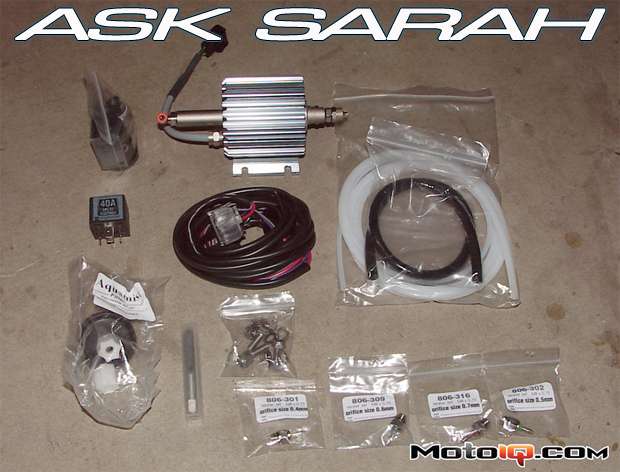,
 |
| You'll have to decide how large a tank you can accomodate, both in size and the additional weight running a larger tank. Tanks are typically available from half a gallon (2 liters) to 6 gallons. Choose based on how long you'll be using the system (at least a full track session) and how much boost you're running. |
Methanol also increases octane, essentially increasing the knock threshold of your fuel grade. It has a lower stoichiometric air fuel ratio, the ratio at which oxygen is used up and the fuel burns completely. Gasoline is stoichiometric at 14.7:1, meaning it consumes 14.7 pounds of air per 1 pound of fuel. Methanol is stoichiometric at 6.4:1, so it consumes just 6.4 pounds of air per 1 pound of fuel. Methanol injection will lower your air/fuel ratio (run richer). Left un-tuned, the engine may produce less power, but tuning for this can produce more power than just lowering temps with a 100% pure water injection. FYI: nitromethane, which is used in most drag racing classes like top fuel or funny cars, has a stoichiometric ratio of just 1.7:1!
Once an engine is tuned for a higher ratio of methanol, if the methanol injection runs out suddenly at wide open throttle, the engine will quickly run lean. This is when you are experiencing that whiplash effect of boost cut. If your engine is tuned for any ratio of methanol injection and you run 100% pure water, you may run lean. So to sum up, methanol requires a little more tuning, is harder to find, more expensive, and highly flammable. It's also an irritant so if you're mixing the two, don't confuse which one is which when you get thirsty! But for really high horsepower applications, methanol is the power adder.
 |
| Water alone is preferred for some un-tuned applications, such as carbureted engines, which cannot compensate for the additional fuel injected into the engine like EFI (electronic fuel injected) engines can. No more than a 20% methanol ratio should be used for these engines. However, methanol has a lower freezing point so it's definitely helpful to add if you're boosted ice racing! |
For most tuners, water alone does a great job of in-cylinder cooling and methanol should only be considered an additive to water. Windshield washer fluid that is rated at -20 to -35 degrees below zero is typically 30-40% methanol, though some environmentally friendly ones contain no methanol. Be sure that it also doesn't contain more than 2% of any other additives such as dye or detergents. Windshield washer fluid is probably the easiest way for most users to supply water injection because it provides a good ratio without having to mix it yourself.
Since twice as much methanol as water is needed to cool the cylinders and it evaporates more quickly, it will run out faster than a 100% water injection, as you've experienced. You could definitely increase your track time injecting straight water with a smaller jet since you don't need as much water alone to absorb engine temps. Depending on how aggressively you've tuned for the water/methanol injection and with your setup, any power loss would probably be minimal, if at all. Use distilled water rather than tap water since it contains fewer mineral deposits that can clog your system. If you can control the water/methanol injection delivery and switch maps in real time to retard the boost and tune for a richer air/fuel mixture when the water/methanol injection starts to run low, you might be able to get in a few more laps with the water/methanol injection. But the easiest and longest lasting method would be 100% water injection. If it still doesn't last a full 30 minute session, lose the spare tire and the helmet (wait, not the helmet!) to fit a bigger tank.
Got a difficult tech question? Email Sarah at asksarah@motoiq.com



